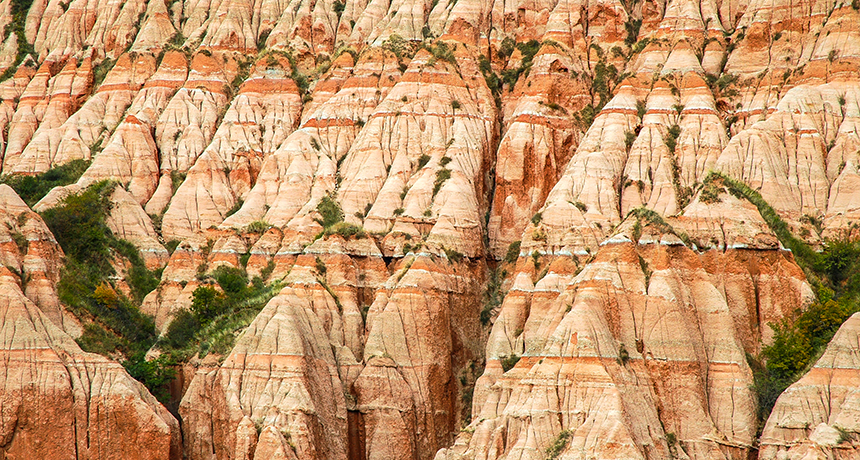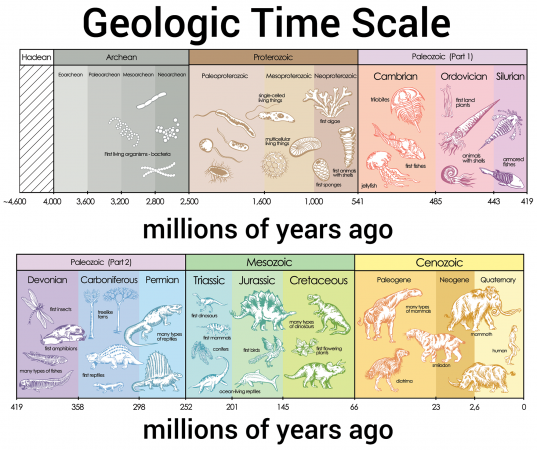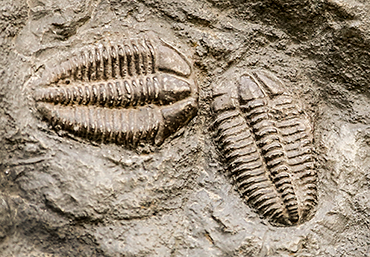Explainer: Understanding geologic time
Here’s how scientists have organized time throughout Earth’s 4.6-billion-year history

These colored bands are one of Earth’s growth charts. They show strata — layers of rock — in Romania containing dino fossils that have been deposited over time. Scientists can date these strata to understand when the fossilized animals within them had lived.
salajean/iStock/Getty Images Plus
By Beth Geiger
Imagine the nearly unimaginable: 4.6 billion years. That’s how old the Earth is — a mind-boggling length of time. And to measure it, scientists use special terms, most of which focus on the planet’s changing geology. That’s why, in fact, it’s known as geologic time.
To grasp just how old Earth is, imagine fitting its entire history into one calendar year. If Earth formed on January 1, the earliest primitive life (think algae) wouldn’t appear until March. Fish first swam onto the scene in late November. Dinosaurs stomped around from December 16 until December 26. The first modern humans — Homo sapiens — were real late-comers. They didn’t show up until just 12 minutes before midnight on New Year’s Eve.
Almost as mind-boggling is how geologists figured this all out. Like chapters in a very, very thick book, layers of rock chronicle Earth’s history. Put together, the rock records the long saga of life on Earth. It shows how and when species evolved. It also marks when they thrived — and when, over millions of years, most of them went extinct.
Limestone or shale, for example, may be the remains of long-gone oceans. These rocks contain traces of life that existed in those oceans over time. Sandstone might once have been an ancient desert, where early land animals scurried. As species evolve or go extinct, the fossils trapped in the rock layers reflect these shifts.
How to track such a long, complex history? Using dazzling detective skills, geologists created a calendar of geologic time. They call it the Geologic Time Scale. It divides Earth’s entire 4.6 billion years into four major time periods. The oldest — and by far the longest — is called the Precambrian. It is divided into Eons known as the Hadean (HAY-dee-un), Archean (Ar-KEY-un) and Proterozoic (Pro-tur-oh-ZOE-ik). After the Precambrian come the Paleozoic Era and Mesozoic Era. Last but not least is the Cenozoic (Sen-oh-ZOE-ik) Era, the one in which we live. The Cenozoic started about 65 million years ago. Each of these Eras, in turn, are divided into increasingly smaller divisions known as Periods, Epochs and Ages.

Unlike months in a year, geologic time periods aren’t equally long. That’s because Earth’s timeline of natural change is episodic. That means changes happen in spurts, rather than at some slow and steady pace.
Take the Precambrian Era. It lasted more than 4 billion years — or for more than 90 percent of Earth’s history. It ran from Earth’s formation until life burst out some 542 million years ago. That burst marked the beginning of the Paleozoic Era. Sea creatures like trilobites and fish emerged and came to dominate. Then, 251 million years ago, the Mesozoic Era burst into being. It marked the biggest mass extinction of all. It also kicked off the spread of life on land. This era then ended abruptly — and famously — 65.5 million years ago. That’s the moment when dinosaurs (and 80 percent of everything else) vanished.
Relative versus absolute ages
So here’s the 4.6-billion-year question: How do we know the actual ages on the Geologic Time line? The scientists who developed it in the 1800s didn’t. But they did understand relative ages, based on a simple, yet powerful principle. That principle is called the Law of Superposition. It states that in an undisturbed stack of rock layers, the oldest layers will always be on the bottom, and the youngest on top.
The Law of Superposition allows geologists to compare the age of one rock or fossil to another. It makes the sequence of geologic events more clear. It also gives clues into how species evolved, and what creatures co-existed — or didn’t. A trilobite, for example, literally wouldn’t be caught dead in the same rock as a pterosaur. After all, they lived millions of years apart.

Still, how can we make sense of a calendar with no dates on it? To assign such absolute ages to the Geologic Time Scale, scientists had to wait until the 1900s. That’s when dating methods developed that relied on radiometric methods. Certain isotopes — forms of elements — are unstable. Physicists refer to them as being radioactive. Over time, these elements shed energy. The process is called decay and will involve shedding one or more subatomic particles. Eventually, this process will leave the element nonradioactive, or stable. And a radioactive isotope always decays at the same rate.
Radiometric age dating is based on how much of one radioactive “parent” isotope has decayed into its stable daughter.
Scientists measure how much of the parent element still exists in a rock or mineral. Then they compare that to how its “daughter” element now exists there. This comparison tells them how much time has passed since the rock formed.
What element they choose to measure depends on many factors. Those can include the rock’s composition, its approximate age and its condition. It also depends on whether the rock had been heated or chemically altered in the past. The decay of potassium to argon, uranium to lead, and one isotope of lead to another are some common yardsticks used to date very old rocks.
These dating methods allow scientists to put real ages on rocks with astonishing accuracy. By about the 1950s, most of the Geologic Time Scale had real dates (described as “years before the present time”).
The exact timing and even the names of some geologic divisions are still not set in stone. Every year, geochronologists (GEE-oh-kron-OL-oh-gizts) — scientists who specialize in dating geologic ages — improve the methods to zoom in more accurately. They can now distinguish events that occurred just a few thousand years apart, back tens of millions of years ago.
“This is an exciting time,” says Sid Hemming. She’s a geochronologist at Columbia University in New York City. “We are refining our analyses of geologic dates. And this is allowing ever more control on the time scale,” she says.

Never-ending story
Right now, new layers of limestone and shale are forming at the bottoms of Earth’s oceans and lakes. Rivers move gravel and clay that will someday become rock. Volcanoes spew out new lava. Meanwhile, landslides, volcanoes and shifting tectonic plates constantly re-shape Earth’s surface. These deposits slowly add layers that will end up marking the current geologic period. It’s known as the Holocene.
And now that people have been around for the equivalent of 12 seconds, some geologists propose adding a new period to the Geologic Time Scale. It will mark the time since humans began altering Earth. Starting about 10,000 years ago, it is tentatively being called the Anthropocene.
Its geologic layers will be quite a mix. They will hold plastics, petrified food wastes, graveyards, discarded cell phones, old tires, construction debris and millions of miles of pavement.
“Far-future geologists will have a huge set of puzzles on their hands,” says Jan Zalasiewicz. He works at the University of Leicester in England. As a paleobiologist, he studies organisms that lived in the distant past (such as at the time of the dinosaurs). Zalasiewicz recently proposed a name for this growing layer of human-made debris. He calls it the Technosphere.
In Earth’s never-ending story, we are creating our very own addition to the Geologic Time Scale.







